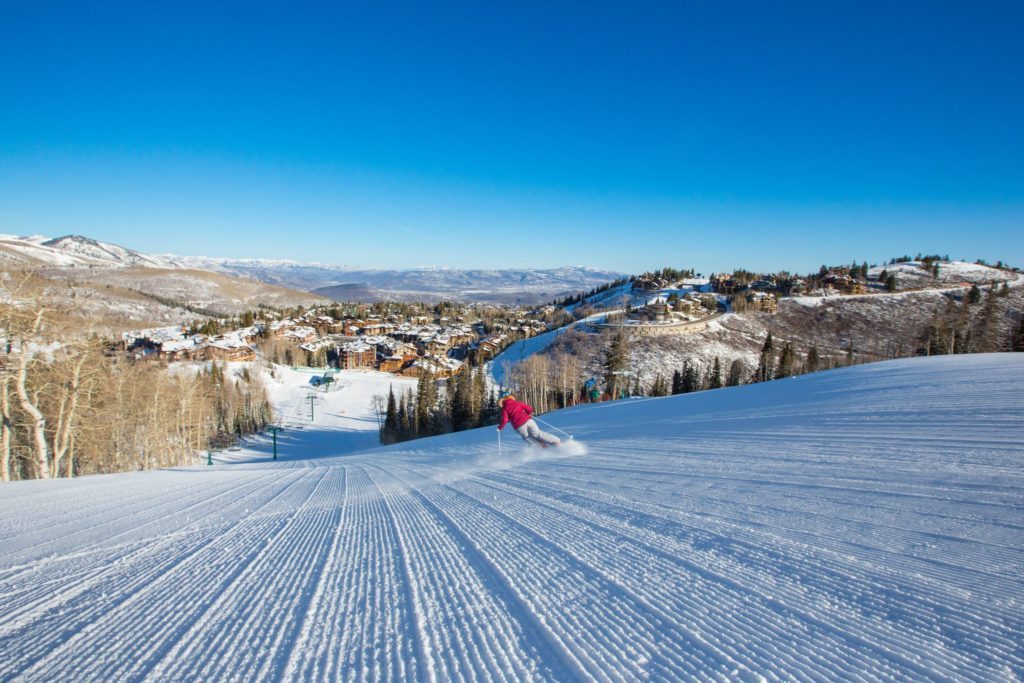Should We Save This Year’s Snow for Next Season?
 Because I love skiing and winter so much, I always have mixed feelings when it’s time to put my ski gear away. In spite of what you might have heard, this past season ended up being another excellent outdoor experience filled with some unforgettable and unique moments for me. This is partly why I reluctantly transition from winter into spring.
Because I love skiing and winter so much, I always have mixed feelings when it’s time to put my ski gear away. In spite of what you might have heard, this past season ended up being another excellent outdoor experience filled with some unforgettable and unique moments for me. This is partly why I reluctantly transition from winter into spring.
Only a few days ago, I drove to Snow Park to observe the retreating Deer Valley “glacier” that still seemed to be thumbing its nose at the upcoming concert season. The World Cup mogul run (Champion) was still holding so well that I almost could have enjoyed a full, top-to-bottom, run. This, of course, is an incredibly strong testimony to Deer Valley Resort’s formidable and generous snow making enterprise. This is when I literally had to pinch myself that we were already smack into the middle of spring and that all that reminiscing wasn’t doing me any good.
 It’s true that I see things differently from most people. This, I assume, is because I was born and bred in the mountains and had learned, early on, to be a keen observer of nature, including snow behavior. From the moment it falls off the sky to the time it finally melts. As a kid I often surprised myself living in an imaginary world of “endless winter.” This is in part why, more than forty years ago, I sacrificed two of my summers to go ski during the length of a full snow season, down under, in Australia. More recently, almost three decades ago, I finally settled in Utah and returned to a genuine mountain environment, following a 10 year hiatus. I began making precise observations and taking notes about our fast vanishing spring and early summer snow.
It’s true that I see things differently from most people. This, I assume, is because I was born and bred in the mountains and had learned, early on, to be a keen observer of nature, including snow behavior. From the moment it falls off the sky to the time it finally melts. As a kid I often surprised myself living in an imaginary world of “endless winter.” This is in part why, more than forty years ago, I sacrificed two of my summers to go ski during the length of a full snow season, down under, in Australia. More recently, almost three decades ago, I finally settled in Utah and returned to a genuine mountain environment, following a 10 year hiatus. I began making precise observations and taking notes about our fast vanishing spring and early summer snow.
Over time, I observed that our snow melted much faster in the late spring, and early summer. Today, I think I can explain it. It’s not so much because of rising global temperatures as most folks would think, but because we, humans, are soiling our snowfields from the Alps to the Himalayas and all the way to the Rocky Mountains. All the particulates and other pollutants that are emitted from Paris’ tiny Diesel cars to Beijing’s coal-fired power plants or our western forest fires, end up gathering high into the atmosphere and eventually drop upon our mountains in such quantities that just a few days after a fresh late-season snowfall, the tiny, dirty deposits take over, soiling the remaining snow that hangs on top of our peaks and glaciers.
On snow, these dirty particulates amount to a huge loss in reflectivity from a normally bright surface. In turn, it increases the penetration of solar heat and hastens the melting process. This new reality of snow melting faster in late season is perhaps what prompted the Winter Olympics organizers in Sochi, Russia, to conserve this year’s snow until these coming February’s events. I can understand why they don’t want to take any chances as the 2014 Winter Games are now closing-in.
As you may have heard, their mountain staff plans to stockpile 500,000 cubic feet of snow into some shady gullies and deep creek beds located above the venues. A Finnish company has been asked to oversee this herculean task. This season’s snow will be covered under insulated blankets. During summer it will melt some and the density or the remaining snow – just like on permanent snowfields before they turn into glaciers – will increase from 25 to 34 lbs/cubic feet. When it’s ready to be used for the 2013-2014 Winter, the snow will be spread over the hills by snow cats or piped down to the slopes that need it.
When I heard about this extreme idea, I wondered if we too, shouldn’t try to “save” our snow season after season? I thought about it long and deep and came to the conclusion that instead, we should be more confident and wait for Mother Nature’s ‘clean’ refills scheduled for November.
So, while I am reminiscing the face shots and other stimulating sensations collected over this past winter, I must also admit that it’s almost early summer and time to move on. Today, I’m getting ready to mentally bid a friendly farewell to the last snow patches, put my skis away for good and get my mountain bike ready so I can ride very soon into another fantastic summer!
*Today, Deer Valley Resort joins with 107 other ski areas as a part of the National Ski Areas Association to sign the Climate Declaration, which calls upon federal policymakers to seize the American economic opportunity of addressing climate change. Ski industry leaders are concerned not just with the threat climate change has to their own operations but also its impacts on rising sea levels, wildlife habitat, the health of our forests, and truly our way of life. We recognize both the risks of inaction as well as the opportunity for U.S. leadership in combating climate change.
The economic influence of our trade is enormous. Ski areas in the U.S. employ about 160,000 people and generate about $12.2 billion in annual revenue. The National Ski Areas Association calculates that visitors to U.S. ski areas spent $5.8 billion at those resorts over the course of the 2011/2012 season. Preliminary figures from the 2012/2013 season show an 11 percent increase in visits year-over-year, to an estimated 56.6 million visits this season.
To read more about Deer Valley Resort’s environmental initiatives please visit: http://www.deervalley.com/About/Information/Environment
To sign the Climate Declaration as an individual or company, visit: http://www.ceres.org/bicep/climate-declaration


 The Official Blog of Deer Valley Resort
The Official Blog of Deer Valley Resort


